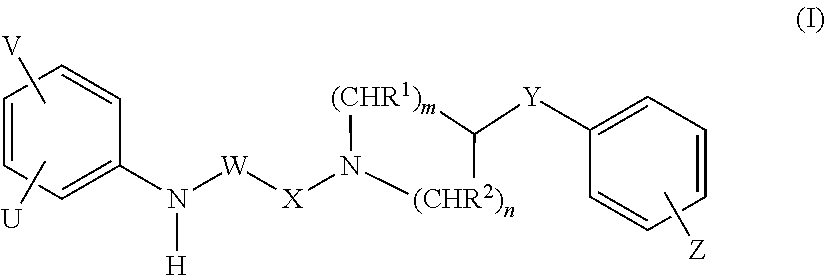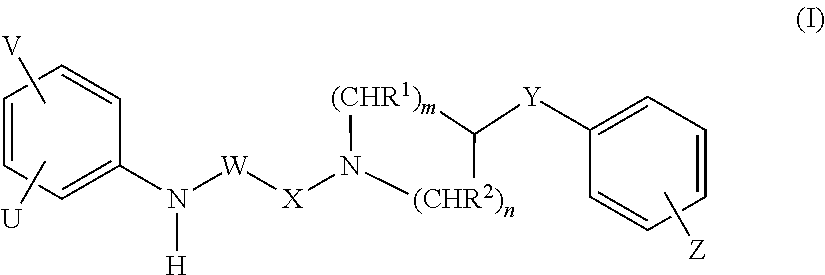Methods for treating CNS disorders
a central nervous system and disorder technology, applied in the field of central nervous system disorders, can solve the problems of robbery of the sufferer of the ability to enjoy activities or relationships, prolonged period of gloom and hopelessness, and impaired cognitive functions
- Summary
- Abstract
- Description
- Claims
- Application Information
AI Technical Summary
Problems solved by technology
Method used
Image
Examples
example 1
[0089]The aim of this study was to evaluate the antidepressant activity of radiprodil. The forced swimming test is a behavioral assay that can be used to predict antidepressant efficacy of drugs in humans.
Animals
[0090]Male NMRI mice weighing 24-26 g were used. The animals were kept in polycarbonate cages in a thermostatically controlled room at 24+2° C. and at a relative humidity (RH) of 50±10%. The room was artificially illuminated from 6 am to 6 pm and the mice were given commercial pellet rat-mouse feed, autoclaved at 105° C. and sterile filtered tap water, ad libitum.
Dosing
[0091]An aqueous solution of radiprodil, in the form of a complex with heptakis(2,6-di-O-methyl)-β-cyclodextrin(DIMEB), was administered orally at doses of 2.5, 5 and 10 mg / kg (calculated for non-complexed radiprodil). DIMEB-80 (heptakis(2,6-di-O-methyl)-β-cyclodextrin with an isomeric purity >80%) was used as the control, dissolved in water at a concentration of 7 mg / ml. All solutions were administered at a v...
example 2
[0102]This study will determine the effects of radiprodil administration on behavioral impairment in triple transgenic mice that act as a model for Alzheimer's disease in humans (3xTg-AD mice) by using well-characterized behavioral assays that are designed to identify deficits in spatial memory, object recognition and fear conditioning.
Design and Methods
[0103]Mice: 3xTg-AD mice with a hemizygous (PS1M146V / PS1M146V; APPSwe+ / 0; TauP301L+ / 0) and homozygous (PS1M146v / PS1M146V; APPSwe+ / +; TauP301L+ / +) genotype will be used. The mice develop both plaques and tangles in a hierarchical, region specific and age-progressive manner that mimics the development of Alzheimer's disease in humans. See Oddo et al., Neuron, 39(3), 409-421, 2003. This study will focus on behavioral changes in 3xTg-AD (homoz) mice administered radiprodil. Age- and sex-matched non-transgenic (NonTg) mice will also be included as a control group.
[0104]Subjects and drug administration: 9, 12 and 15-month-old mice will be ...
example 3
[0121]A patient with Alzheimer's disease presents to a physician's office or clinic. To improve the patient's symptoms, the patient is administered between about 1 and about 150 mg radiprodil per day. The patient's vital signs and an ECG are recorded. Adverse events are also recorded. Physical examinations are conducted and blood and urine samples are collected. At the discretion of the physician, the dosage of radiprodil can be reduced or increased as required. The results from the above treatment regimen may surprisingly show that radiprodil can be used to safely and effectively treat Alzheimer's disease.
PUM
| Property | Measurement | Unit |
|---|---|---|
| concentration | aaaaa | aaaaa |
| diameter | aaaaa | aaaaa |
| height | aaaaa | aaaaa |
Abstract
Description
Claims
Application Information
 Login to View More
Login to View More - R&D
- Intellectual Property
- Life Sciences
- Materials
- Tech Scout
- Unparalleled Data Quality
- Higher Quality Content
- 60% Fewer Hallucinations
Browse by: Latest US Patents, China's latest patents, Technical Efficacy Thesaurus, Application Domain, Technology Topic, Popular Technical Reports.
© 2025 PatSnap. All rights reserved.Legal|Privacy policy|Modern Slavery Act Transparency Statement|Sitemap|About US| Contact US: help@patsnap.com


